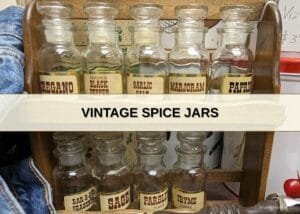Vintage canisters aren’t just storage accessories anymore; they’re hot collectibles that have been selling for hundreds to over a thousand dollars! So, if you have old canisters and want to know whether they’re worth the fortune, this is the guide you need.
This guide will not only explain how to identify antique canisters and understand what makes them valuable, but will also introduce you to the 12 rare vintage canisters worth a lot of money!
How to Identify & Date Vintage Canisters (4 Key Signs)
First, let’s talk about how to tell if that canister you’re eyeing is actually vintage and not just made to look old (yep, there are plenty of reproductions out there!).
Materials
- Tin (1840s-1950s): The OG canister material! These were the workhorses of the 19th-century kitchen. I found a set at an estate sale with a coffee advertisement from 1910 – they’re definitely not perfect, but boy, do they have character. Tin canisters can be valuable if they have cool advertising or rare patterns.
- Ceramic (1900s-Present): Ceramic canisters, most stoneware, earthenware, and porcelain hit their stride in the early 20th century. Authentic examples typically have aging signs like crazing.
- Glass (1880s-1950s): By the late 1800s, glass canisters became all the rage. You’ll find clear pressed glass, colored depression glass, and milk glass varieties. Many were designed to fit in those gorgeous Hoosier cabinets.
- Enamelware (1930s-1970s): These colorful beauties combine metal with a durable enamel coating. My aunt had a bright red set that I always admired growing up. You’ll pay anywhere from $40 for a basic set to $400 for rare colors or designs in perfect condition.
- Aluminum (1930s-1960s): After WWII, aluminum production went through the roof, and so did aluminum canisters! They typically have that distinctive spun or brushed finish that screams mid-century modern.
Maker’s Marks
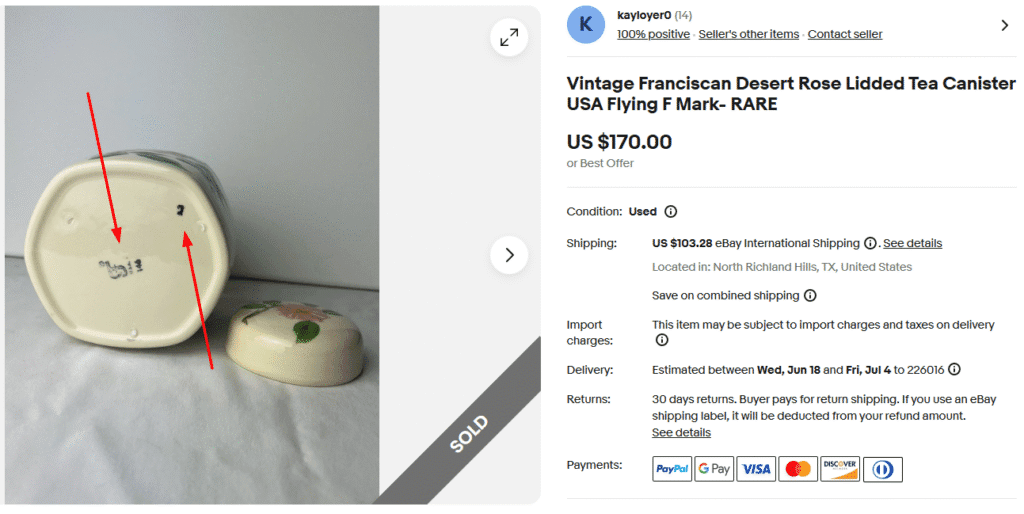
One of the first things I do when I find an interesting canister is flip it over! Those markings on the bottom can tell you so much:
- Manufacturer’s Marks: Check the bottom or inside the lids for company names, logos, or code numbers. Some companies, like Hall China, changed their marks over time, which helps you pinpoint exactly when a piece was made.
- Patent Numbers: These can be goldmines for dating! A patent number tells you when the design was approved, giving you the earliest possible manufacturing date. The way patents are marked has changed over time too, from “PAT.” to “PAT. PENDING” to full patent numbers.
- Country of Origin: If it says “Made in USA,” it’s probably from after 1930. Found one marked “Made in Occupied Japan”? That’s a specific period piece from 1945-1952!
- Original Labels: Collectors get really excited when they find canisters with their original paper labels intact. Not only do they tell you more about the maker, but they also boost the value significantly.
Design Elements
Looking at an old kitchen canister tells you a lot about when it was made. Here are the key things to look for:
Typography and Graphics
- Late 1800s/Early 1900s: These canisters often had fancy, flowery lettering, sometimes hand-painted or stenciled on. The pictures were usually pretty realistic – what you see is what you get.
- Art Deco (1920s-30s): This era loved clean lines and geometric shapes. You’ll spot bold, sans-serif fonts that look sleek and modern, often with metallic touches.
- Mid-Century Modern (1940s-60s): This is when design got playful. Look for fun, casual fonts that feel hand-drawn. The graphics went abstract – atomic starbursts, boomerang shapes, or stylized leaves and flowers. Colors? They went wild with bright, bold palettes.
Color Choices
The colors tell you a lot, too. Soft, dreamy pastels were big in the 30s, while the 50s and 60s cranked up the volume with vibrant primary colors that popped in the kitchen.
Lid Styles
- Friction Fit: Common on tin and ceramic pieces – the lid just pushes in or slides over the top
- Screw-Top: Found on glass and some ceramic pieces when people wanted a better seal
- Clamp-On/Bail: Like old Mason jars, with that wire thing that clamps down on a rubber gasket
- Cork Stopper: Shows up on early spice jars, especially glass or ceramic ones
- Glass Stopper: The fancy option, usually ground to fit just right
Shapes
While most canisters are round, keep an eye out for square ones, rectangular ones, or even fun shapes like those apple cookie jars. Sets usually came in different sizes that nested nicely together.
Themes
Most kitchens had the classic “Tea, Coffee, Sugar, Flour” set, often with matching smaller spice jars. You’ll also spot some unique designs, including patriotic designs, flower patterns, or kitchen-themed pictures that matched the era’s style.
Era & Style Clues
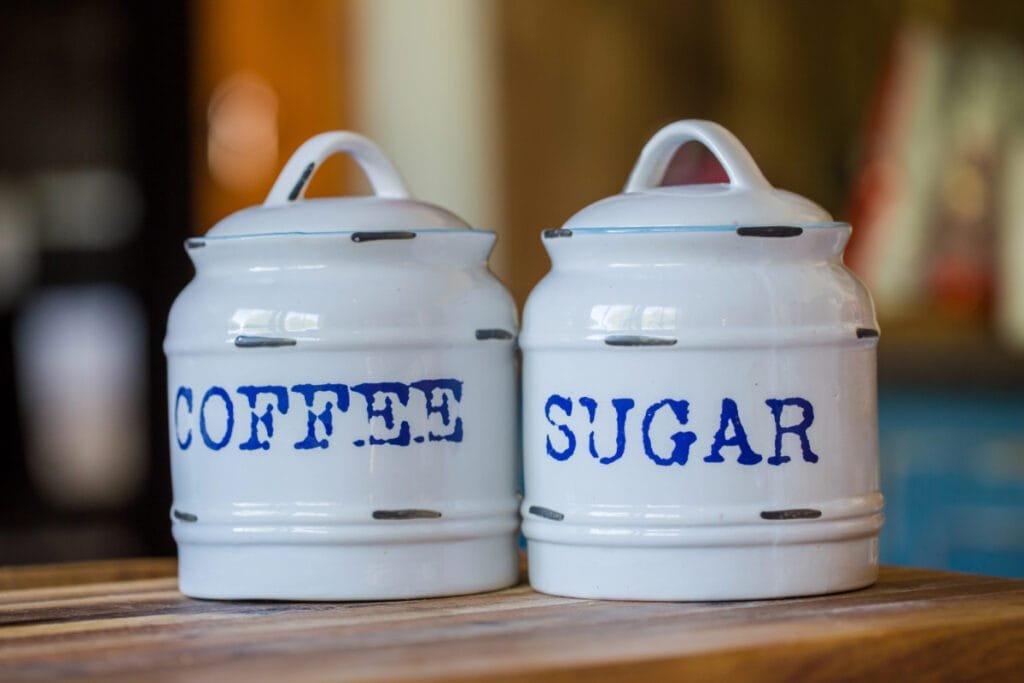
The look and feel of a canister set can instantly place it in a specific time period:
- Victorian Era (1837-1901): Think elaborate, fancy designs with lots of flowers and nature motifs. Colors were rich and deep, and the lettering for “Coffee” or “Tea” was often very formal and fancy.
- Art Nouveau (1890-1910): These canisters have flowing, organic designs inspired by nature, but more stylized and artistic than Victorian patterns. Look for whimsical vines, flowers, and asymmetrical designs.
- Art Deco (1920s-1930s): Bold geometric patterns, strong contrasting colors, streamlined shapes, and chrome accents are hallmarks of this period. The lettering is often very modern and graphic.
- Mid-Century Modern (1940s-1960s): Clean lines and space-age designs dominate here. You’ll see bright colors, atomic starburst patterns, and angled handles. Many MCM canisters had colorful plastic lids that contrasted with the canister body.
- Country/Rustic (1970s-1980s): These bring back memories of my childhood kitchen! Earth tones (those browns, mustards, and avocado greens), folk art, and floral decorations were everywhere.
What Makes Antique Canisters Valuable?
So you’ve found some vintage canisters – are they valuable? Here’s what determines their worth:
- Condition: Canisters without damage (no rust, chips, cracks, or dents) with their original finish and vibrant colors can be worth 2-3 times more than damaged examples. Rust or corrosion on metal canisters, chips in ceramic or glass pieces, faded lettering, missing lids, stains inside, and paint loss are all problems that will lower the value.
- Completeness: A complete matching canister set (typically 4 pieces) with all original lids can be worth 2-5 times more than individual pieces. If the set includes original accessories like scoops, measuring spoons, or display stands, the value jumps even higher. Original packaging or promotional materials? Even more valuable!
- Rarity: Some canister designs or colors were only made briefly or in small numbers. These are the pieces that make collectors’ hearts race! Also, certain manufacturers have serious fan clubs. Kromex aluminum, Hall China, McKee Glass, Anchor Hocking, and Fire King Jade-ite canisters are the most desirable!
- Size: Many vintage sets were designed with graduated sizes. When the sizing progression is intact and the pieces nest properly (if they were designed to), collectors get extra excited.
12 Examples of Rare Vintage Kitchen Canisters Worth Money
Here are 12 rare vintage canisters you must find in your kitchen right away!
1. Fabienne Jouvin Paris Enamel Cloisonné Canister

This French Fabienne Jouvin Paris cloisonné canister is an example of how food storage can become fine art. Created by renowned French designer Fabienne Jouvin in the 1990s, these copper and enamel canisters feature intricate geometric patterns made via the ancient cloisonné technique.
With a blend of contemporary design and traditional medium, these unique canisters have become highly collectible. The vibrant yellow sunburst pattern on this piece is typical of her signature style, which often incorporates bright colors and bold geometric designs.
2. Vintage Lenox Spice Village Porcelain Canister Set
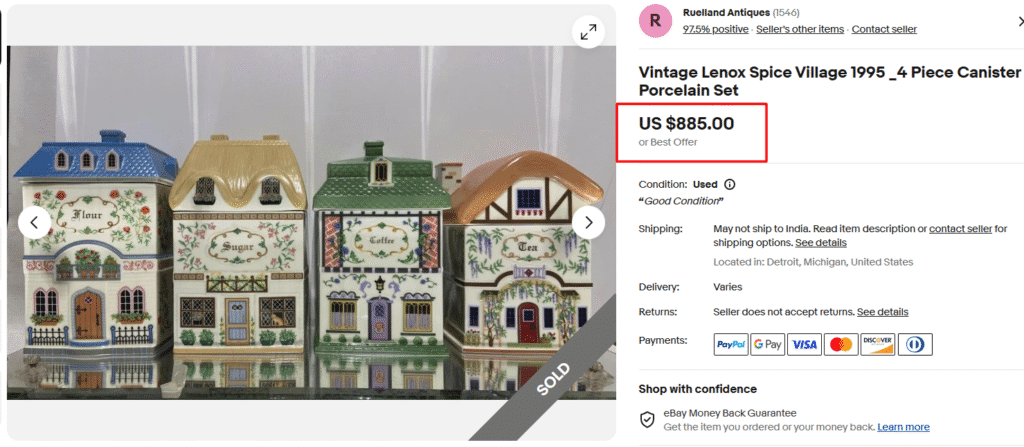
This is a collector’s charm! The Lenox Spice Village porcelain canisters, first released in 1989 as a subscription service, have become viral sensations. Each of the canisters shaped as little buildings serves as both practical storage and decorative art.
The surge in popularity on social media has driven prices sky-high, with complete sets fetching anywhere from $700-$1,500, based on the number of canisters. These canisters were sold as a complete 24-piece village set.
3. Antique McKee Canister
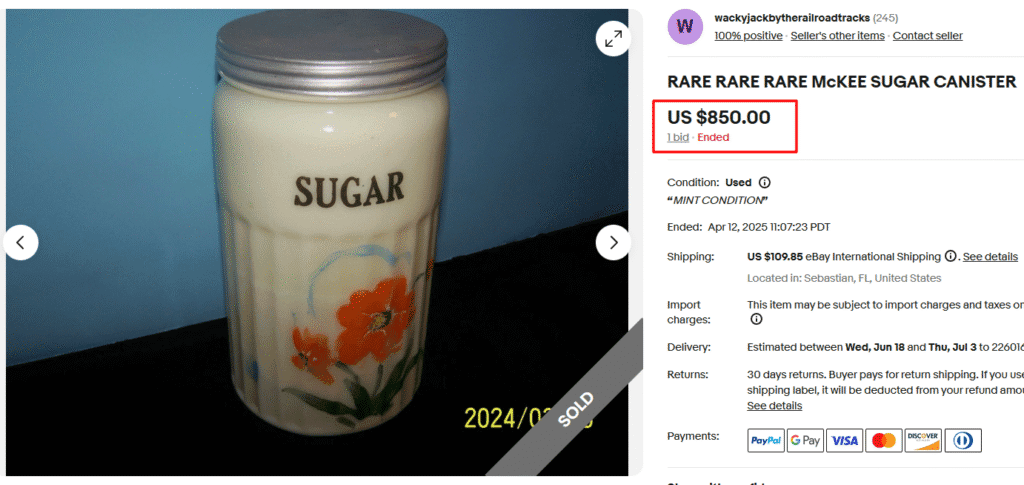
The stunning price tag of $850 shows that McKee glass canisters are really hot collectibles today! This one is a painted creamy ivory color known as “custard glass,” which was particularly popular during the Depression era of the 1930s.
This piece features striking hand-painted orange poppies against that soft background, complemented by the rustic tin lid. Single pieces may go for only $20-$80, but sets can command $100-$1,000+.
4. LE Smith Moon And Star Canister Set
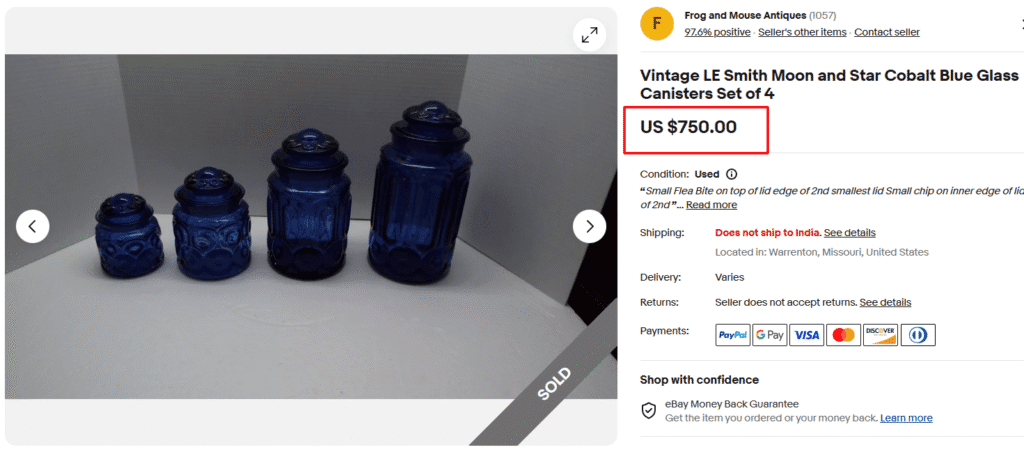
Sold for $750, this magnificent LE Smith Moon and Star cobalt blue glass canister set is a rare find! This graduated set of four features the iconic raised moon and star pattern featuring raised stars surrounding crescent moons, which became wildly popular in the 1960s-1970s.
L.E. Smith Glass Company produced this pattern from the 1960s through the 1980s, but the deep cobalt blue is particularly rare and valuable, far more so than the amber, clear, or green versions. These pieces command premium prices because they’re harder to find, with sets fetching $300-$1,000+!
5. Brush McCoy Yellow Ware Bluebird Beans Canister
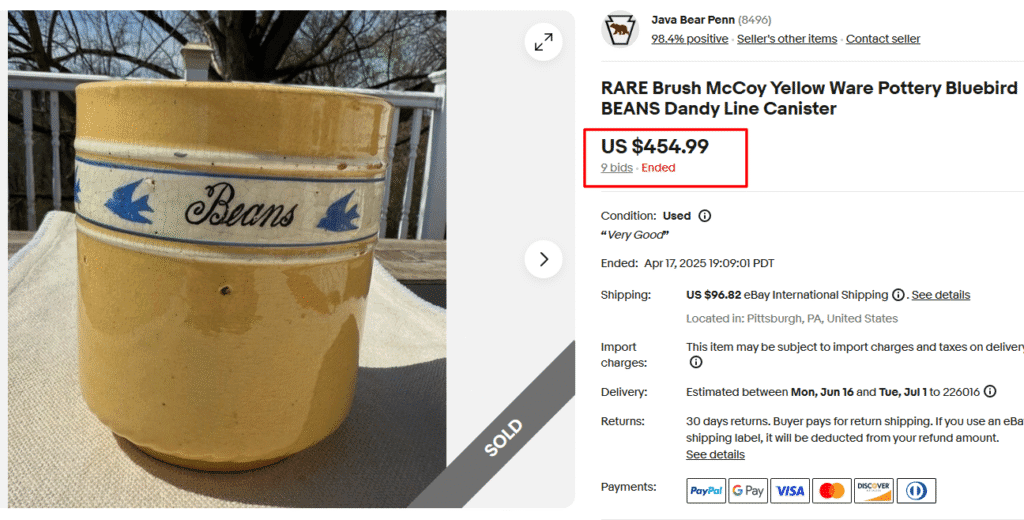
This yellow ware pottery “Beans” canister with charming blue bluebirds isn’t just pretty – it’s a genuine piece of American pottery history. Part of the Dandy Line collection from Brush-McCoy Pottery, this canister dates back to around 1915, when the company was still fairly new.
Brush-McCoy’s, formed in 1911, introduced Dandy Line kitchenware around 1915 and featured yellow glazed pottery with distinctive white bands. Depending on the condition, these rare canisters can fetch $100-$500 or more!
6. West Bend Orange Aluminum Canister Set

The bright orange West Bend aluminum canister set screams 1960s kitchen design. This complete 4-piece set was sold with its original box (a big plus for serious collectors) and features bold orange aluminum with black plastic lids and delicate flower designs.
West Bend was a well-known American kitchenware manufacturer, and this Mid-Century Modern set showcases the company’s eye-catching designs. What makes this set particularly valuable at almost $300 is its unique color (and condition). Regular colorless aluminum canisters typically sell for less.
7. Vintage McKee Jadeite Canister

While most McKee canisters are collectible, the special Jadeite ones have a fan following of their own! Why? Because McKee was the first company to produce this distinctive mint-green milk glass in the 1930s.
This unique canister’s color was achieved by adding uranium to the glass formula, giving it that distinctive glow under black light. McKee’s jadeite was produced for a relatively short period, making authentic canisters increasingly valuable, with full sets fetching $500–$1,200+!
8. Hoosier Kitchen Cabinet Coffee Tea Canister Set
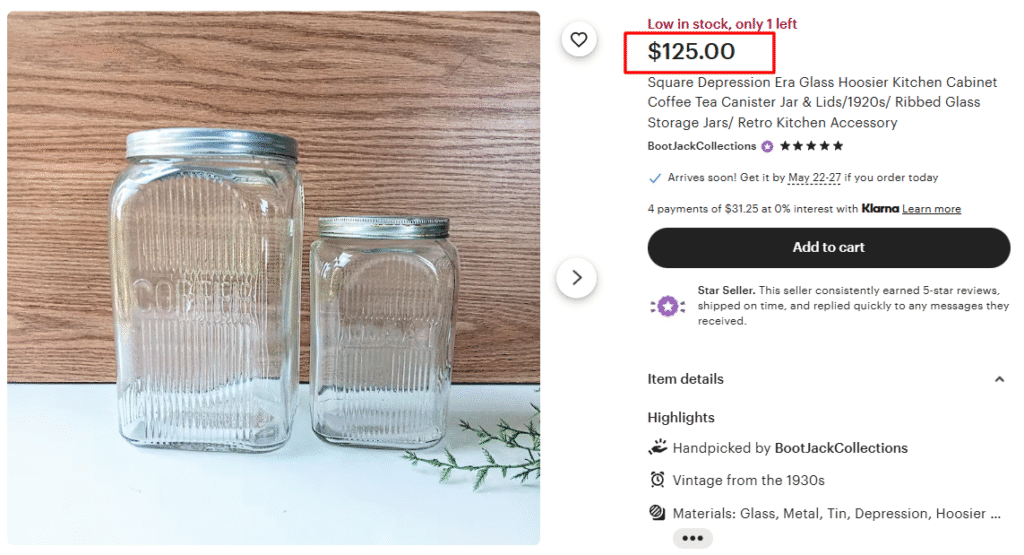
The Depression-era Hoosier glass canisters are highly popular! Made for the popular Hoosier kitchen cabinets of the 1920s-30s, these ribbed square jars with metal lids are also quite functional, making them worth the money ($100–$500, depending on condition).
The canisters were primarily manufactured by Sneath Glass Company, with sets typically including coffee and tea canisters and matching spice jars. These jars are known for their ribbed or etched glass bodies and metal lids.
9. Fire King Anchor Hocking Milk Glass Canisters
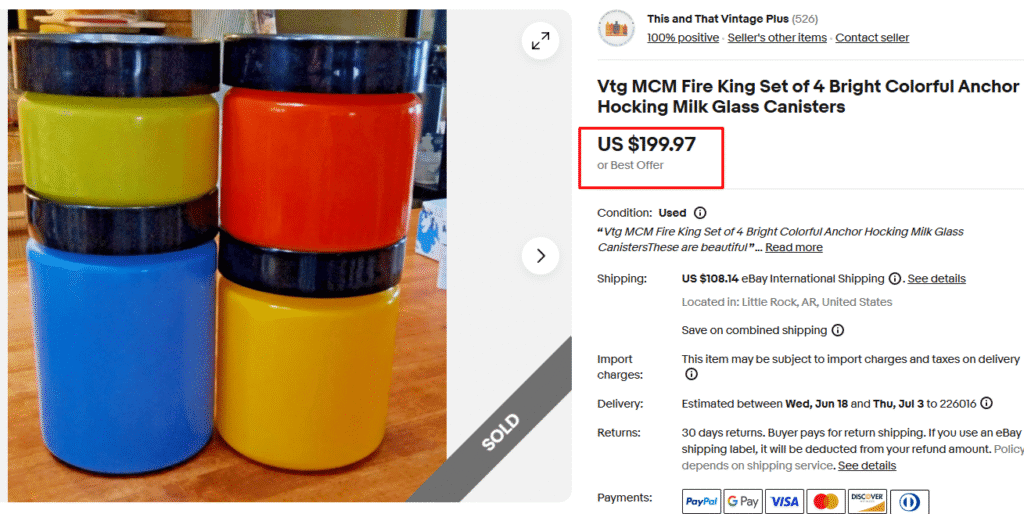
Every collector has or wants to have these vibrant Fire King canisters from Anchor Hocking in their collection! Made of milk glass with bright yellow, red, blue, and gold bodies paired with navy blue plastic lids, this set of four exemplifies the colorful aesthetic of 1960s and 70s kitchen design.
These canisters belong to the Fire King, a line produced by Anchor Hocking Glass Company from the 1940s through the 1970s. Known for durability and heat resistance, Fire King pieces were quite practical and now collectible.
10. Antique French Enamel Canister Set
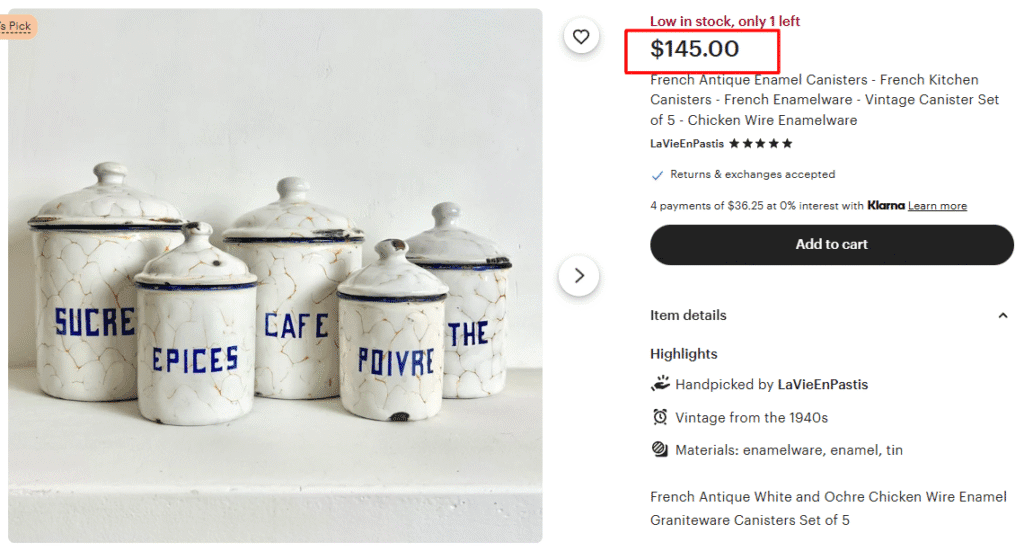
This is a set of five French enamelware canisters. Dating from the 1940s, these white enamel-coated tin canisters feature the distinctive “chicken wire” or crackled pattern that’s highly sought after by collectors.
The blue French lettering identifies each canister’s purpose: SUCRE (sugar), EPICES (spices), CAFE (coffee), POIVRE (pepper), and THE (tea). What makes this pattern special is the beautiful ochre/mustard yellow that shows through the crackled white surface, creating that distinctive chicken wire effect.
11. Vintage Sweet Burley Tobacco Canister
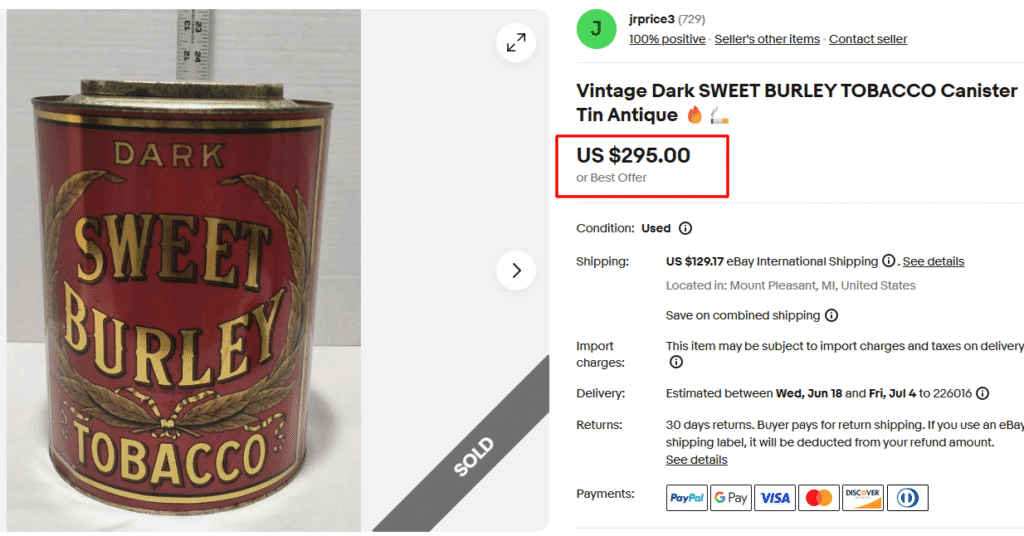
This eye-catching Deep Sweet Burley Tobacco tin is an example of American advertising and packaging design. This large, cylindrical canister boasts a rich red background with the product name displayed in varying typography styles and sizes to create visual impact.
It was manufactured by Spaulding & Merrick of Chicago, Illinois, a leading tobacco producer in the early 1900s. The tin’s design employs classic early 20th-century commercial art techniques. In good condition, such vintage tin canisters can fetch $100-$500+!
12. Kromex Brushed Aluminum Canister Set Turquoise

That sleek set of brushed aluminum canisters with turquoise lids is a pure mid-century modern example. Made by Kromex, specialized in spun aluminum kitchenware, these canisters were the height of kitchen fashion in the 1950s and early 1960s.
The set includes four graduated canisters labeled “FLOUR,” “SUGAR,” “COFFEE,” and “TEA” in black lettering on the turquoise plastic lids. Each canister features a clean, minimalist design with brushed aluminum bodies and matching aluminum knobs on top of the colored lids.
While Kromex produced these sets with black, yellow, and occasionally pink lids, the turquoise version is harder to find today.
Note: This article is intended for informational, educational, and entertainment purposes only. Some images are illustrative and may not represent actual brands, products, or related entities. All trademarks, product names, brand logos, packaging, and other intellectual property referenced remain the exclusive property of their respective owners. Any brand mentions or references are provided solely for descriptive and educational context and do not imply any formal or commercial association.



